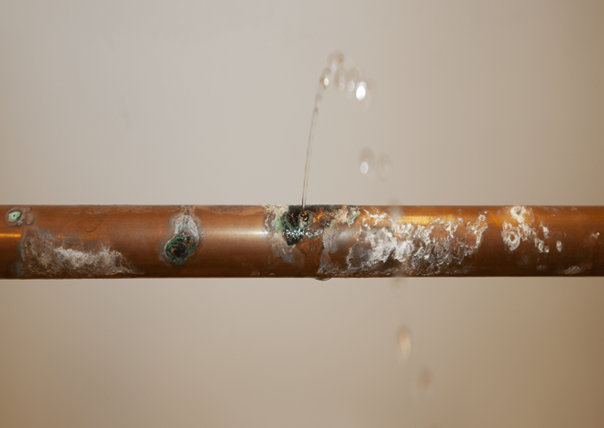Many housing and condominium associations must decide whether to replace water and sewage pipes. The risk of water leakage needs to be weighed against the costs of fully or partially upgrading the pipe system. A systematic lifespan assessment can provide the board with a good basis for making the decision.
A lot can go wrong
Leaks in water and sewage systems can occur in different ways, and the consequences vary depending on the location of the leak and which materials are affected.
- A leak in a hidden installation on a high floor can cause more damage than a leak in the basement.
- If the water supply is interrupted, several residential units could be result in extensive water damage. In the worst case, the homes would need to be rehabilitated, and the residents would have to move out while the damage is repaired.
- Small leaks are not always detected immediately, but over time can lead to significant damage, such as rot, mould and odour, as well as swelling and salt migration in structures.

Expensive wear and tear: Carrying out a life expectancy assessment in time can prevent leaks due to corrosion damage to the water pipe. Photo: SINTEF
Finding the right time for a complete or partial replacement of the water and sewage system is therefore both financially and practically worthwhile.
Researchers at SINTEF have been assessing the condition and remaining life of pipe systems for over 20 years, and we are regularly contacted by condominium owners who wonder whether and when they should replace their pipework. We conduct inspections and laboratory tests to assess the condition of the water and sewage system. Our assessments and recommendations are summarized in a report.
How we calculate condition and remaining life
Age is a simple indicator for assessing the remaining life of pipes, and lifespan tables published by the SINTEF Byggforskserien (Building Research Design Guides) provide helpful guidance. However, age alone does not take into account factors such as load, temperature or water quality.
A more accurate assessment of the condition of pipes requires material samples and laboratory analysis (Norway’s NS 3424 standard, level 3). Remaining life is calculated based on the corrosion rate and remaining material thickness. However, such a calculation assumes that this rate is uniform. Changes in water quality and use can affect the corrosion rate, and the calculated remaining life is therefore only indicative.
It is also important to be aware that couplings and valves may have a shorter lifespan than pipes, and that hidden joints increase the risk of damage.
Material samples from critical points in the pipe system provide the best basis for a reliable assessment. Good sampling points can be easily identified if we have access to accurate and up-to-date drawings of the building and the pipe system.
Are the maps and terrain in sync?
However, it is not always practical to retrieve all samples, which might be hidden behind recesses in a bathroom, for example. In addition, the drawing may be outdated, and changes to the installation may have been made without being documented.
An inspection is therefore useful for assessing the correspondence between the drawings and actual installation. At the same time, a cost/benefit assessment should be made for each material sample. If the location for sampling is not easily accessible, the cost will be high.
The frequency of damage should also be included in the assessment. If several leaks have recently occurred, it would be natural to consider replacing the entire pipe system, even if the age indicates that the pipes could last longer. Previous replacements might have led to a confusing system with varying material quality and age.
Upgrade plan and prioritization
Once the condition and remaining life have been assessed, a decision must be made as to which measures should be implemented – and when. We recommend creating an upgrade plan in which necessary measures are prioritized based on technical condition, damage history and overall assessment.
Upgrade measures on the pipe system should be considered in connection with the condition of the wet rooms to avoid extensive demolition work. If the installations are generally in good condition, local repairs may be appropriate. In the event of a high risk of leakage due to varying quality of the wet room installations, or in the event of extensive wear, replacing the entire system may be more appropriate.
Coordinated rehabilitation includes replacing water and sewage pipes, sealing layers, drains, surfaces and electrical installations. The work involves noise and dust, especially during the demolition phase, and the bathroom will typically be out of service for 4–6 weeks. However, the result is a comprehensive system without weak interfaces.
Relining is a method for extending the service life of sewage pipes. Epoxy is applied to the inside of the pipes either by spraying or as a fibre stocking saturated with epoxy. This method can be considered if the water pipes have a longer remaining life than the sewage pipes. It requires less intervention and shorter downtime, but can still involve more difficult work if the drains have to be replaced.
Thorough assessment provides security
Extensive work and significant costs are usually associated with maintaining and rehabilitating water and sewage systems in housing and condominium associations. A thorough life cycle assessment provides increased security that the chosen solution is correct, and it forms a solid basis for a predictable and effective maintenance plan.


